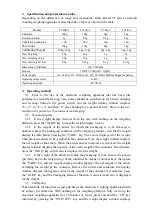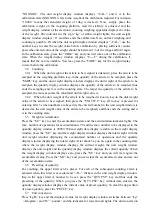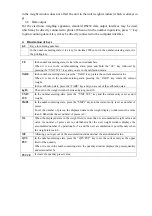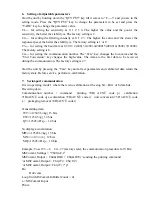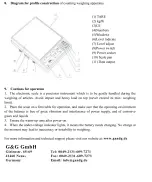
6. Setting of adjustable parameters
Start the unit by holding down the “QTY PST” key till it comes to “F----3” and you are in the
setting mode. Press the “QTY PST” key to change the parameters to be set and press the
“TARE” key to change the parameter value.
C1---- for setting the sensitivity at 0 1 2 3 4. The higher the value and the poorer the
sensitivity, the better the stability is. The factory setting is 2.
C2---- for setting the filtering intensity at 0 1 2 3. The higher the value and the slower the
response speed, the better the stability is. The factory setting is 1 or 0.
C3---- for setting the baud rate at 1(300
)
2(600) 3(1200) 4(2400) 5(4800) 6(9600) 7(19200).
The factory setting is 6.
C4---- for setting the communication number. The “Tare” key changes the low-value and the
“Unit Conversion” key changes the high-value. The data are the first data to be received
during the communication. The factory setting is 27.
Start the unit by pressing the “Tare” key and all set parameters and calibrated data return the
factory state. Before service, perform re-calibration.
7. Serial-port communication
It is in operating mode 1 where there is no calibration at the stop bit—Bit 1 of 8 data bits.
Receiving data:
Communication command printing 70H( ACS
Ⅱ
code p) calibration
71H(ACS
Ⅱ
code q) accumulation 72H(ACS
Ⅱ
code r) unit conversion 73H (ACS
Ⅱ
code
s
)
packaging removal 74H(ACS
Ⅱ
code t)
Transmitting data:
WT
□□
12345.6
□
kg
↓
15 bits
UW
□
1234.5
□
g
↓
12 bits
QT
□
12345
□
Pcs
↓←
14 bits
To display accumulation:
MW
□□
12345.6
□
kg
↓
15 bits
MN
□□□
12
□□□□↓
12 bits
MQ
□
12345
□
Pcs
↓←
14 bits
Example: To set C3---6 C4—27 (factory state), the communication procedure for VB is:
MSComm1.Settings = "9600,n,8,1"
MSComm1.Output = Chr(&H1B) + Chr(&H70) ’ sending the printing command
’or MSComm1.Output = Chr(27) + Chr(112)
’or MSComm1.Output =Chr(27) +"p"
Do
DoEvents
Loop Unti MSComm1.InBufferCount = 41
a = MSComm1.Input
Print a


